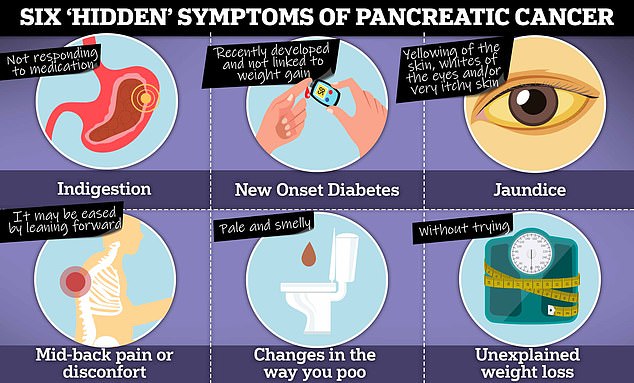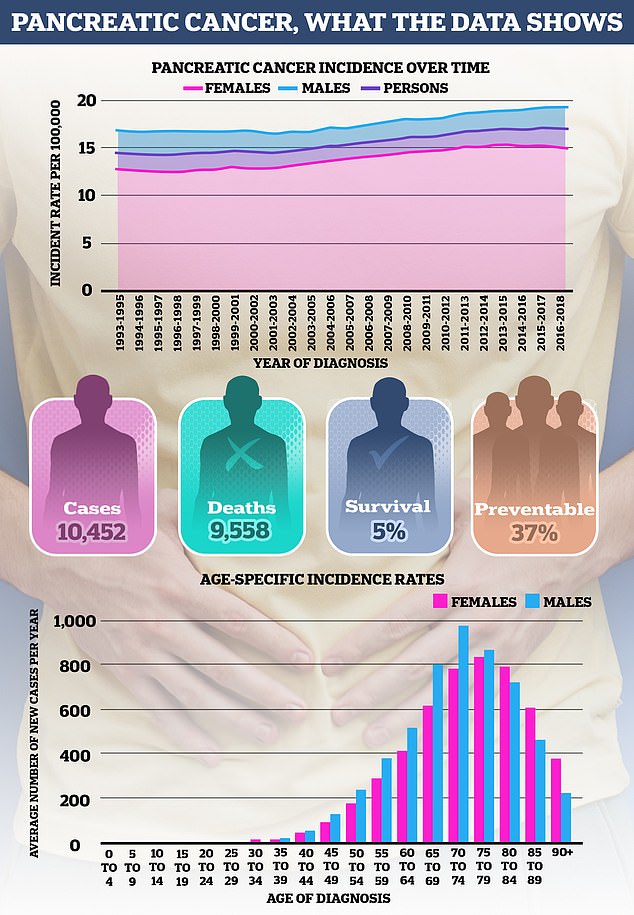- EXPLORE FURTHER: Alert issued regarding potential link between widely used supplement and heightened chance of bowel cancer
Health authorities are planning to implement an innovative screening program designed to provide much-anticipated hope for individuals diagnosed with the deadliest form of cancer in the UK.
Pancreatic cancer, often referred to as a 'silent killer' because of its inconspicuous symptoms, leads to approximately 10,000 deaths annually, which equates to roughly one death per hour.
It is usually identified at advanced stages because the early indicators are often misinterpreted as other issues.
However, now GP clinics will reach out to patients who are considered at high risk of the disease, and summon them for immediate testing in an effort to anticipate symptoms before they appear.
Individuals deemed at risk of contracting the disease include those above 60 years old who have recently received a diagnosis. diabetes or sudden weight loss.
Even though many advancements have been made for other types of this condition, enabling patients to survive longer, the prognosis for pancreatic remains bleak. cancer patients remains shockingly dismal.
Only about five out of every 100 individuals who receive this diagnosis are anticipated to survive into the following ten years, with over half passing away within merely three months.
The new NHS The pilot, which includes over 300 general practice clinics in England, seeks to identify patients during the initial, most curable phases of the condition.


Health service authorities anticipate that the £2 million initiative, set to commence fully this fall, aims for a minimum of 300 early detections.
At present, merely around twenty percent of pancreatic cancer patients receive their diagnosis during the initial phases of the illness when therapeutic interventions are most likely to be effective.
Medical professionals will particularly search for instances of recently developed diabetes because data indicates that approximately half of all pancreatic cancer patients are identified as having this blood sugar disorder just prior to being diagnosed with the illness.
This occurs due to the cancer damaging the insulin-generating cells in the pancreas—the ones responsible for regulating blood sugar levels—that are similarly harmed in cases of diabetes.
These individuals will be summoned for critical blood work and diagnostic imaging.
When pancreatic cancer is detected early, prior to spreading across the body, approximately 50% of patients can expect to live for at least one year.
However, if the cancer has already disseminated beyond the organ—which occurs in most cases—only one out of every ten patients will live for more than a year.
Professor Peter Johnson, the NHS national clinical director for cancer, stated: "Pancreatic cancer leads to numerous fatalities due to patients typically not recognizing symptoms until the disease has reached an advanced phase. This is why we must discover innovative methods of detecting it earlier."


If your primary care clinic determines that you have an increased risk of pancreatic cancer, I strongly encourage you to get tested without delay.
Karin Smyth, the health minister, stated: "By adopting this focused strategy to pinpoint individuals who may be vulnerable to one of the deadliest forms of cancer, we can enhance the prospects for many and prevent the profound sorrow experienced by numerous households."
Alfie Bailey-Bearfield, who leads influencing and health improvement initiatives at Pancreatic Cancer UK, stated: "A significant number of individuals participating in the trial and undergoing a CT scan may not have pancreatic cancer. However, for those diagnosed with the disease, this intervention has the potential to be truly life-saving."
Depending on the outcome of the pilot program, we aim to expand it nationwide to provide better opportunities for those impacted by one of the most lethal widespread cancers, thereby enhancing their chances of survival.
Studies have indicated that individuals above the age of 50 who receive a recent diagnosis of type 2 diabetes are more likely to be identified with pancreatic cancer within a span of three years.
Although pancreatic cancer predominantly affects individuals over the age of 75, with 47 percent of all cases occurring within this group, younger populations can still develop the disease.
Last year, MailOnline brought attention to 'frightening' surge in young women contracting the disease.
The incidence of pancreatic cancer has increased by as much as two-fold in females younger than 25 years old since the 1990s.
Even though the figures are still small, oncologists are unable to account for the increase in younger females, whereas no similar rise has been observed among males of the same age group.
In total, cases of the disease have risen approximately 17 percent in Britain during the corresponding period, with rising obesity rates believed to be driving this increase.
In recent times, several high-profile cases of pancreatic cancer among celebrities have brought this disease into the limelight.
In the previous year, Sven-Goran Eriksson, who previously managed England at age 76, died following a struggle against the illness.
Other renowned casualties include iconic actors Patrick Swayze and Alan Rickman as well as Apple’s legendary co-founder Steve Jobs and The Smiths’ bassist Andy Rourke.
Possible signs of pancreatic cancer encompass jaundice, characterized by the yellowness appearing in both the whites of the eyes and the skin, along with itching and more deeply colored urine.
Other potential indicators encompass a decrease in hunger, unintentional weight loss. weight loss , constipation or bloating.
Although these symptoms are probably not indicative of cancer, it is crucial to have them evaluated by a general practitioner promptly, particularly if they persist for more than four weeks.
The pancreas is an organ shaped like a tadpole that is integral to both the digestive process and hormone management.
It sits directly posterior to the stomach and extends for approximately 25 centimeters in length.
As part of its digestive function, it aids in producing enzymes that assist the body in breaking down food into essential nutrients.
It is equally essential in producing hormones that regulate blood glucose levels within the body.
According to Charity Cancer Research UK, approximately 22 percent of cancer cases are attributed to smoking, whereas around 12 percent are linked to obesity.
Read more


%20(1024%20x%201024%20piksel)%20(5).png)
%20(1024%20x%201024%20piksel)%20(1).png)
0 Comments